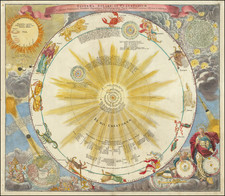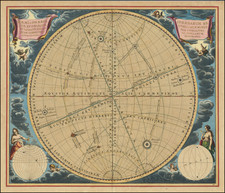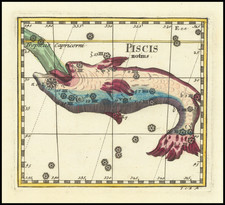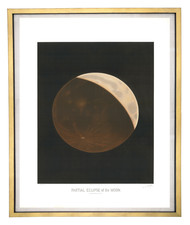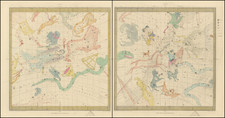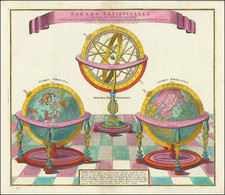A Stunning Lithograph of the Moon Showing a Partial Eclipse. Made by the "Audubon of the Sky", Etienne Trouvelot.
This is a beautiful color lithograph of a partial lunar eclipse made by Etienne Trouvelot, relating his observations made in the fall of 1874. The chromolithograph was published as part of Trouvelot's Astronomical Drawings set of 15 plates by Charles Scribner's Sons in 1882.
Trouvelot's drawings are known as some of the best images of the sky ever made. Trouvelot's work was very important at the time, as it provided important images of the stars, planets, and phenomena of the sky at a time when popular interest in astronomy was growing, but photography had not yet become advanced enough to capture such dark images. Trouvelot's images are recognized as the last of the great images of the night sky that surpassed the photography of their day.
A Blood Moon
Lunar eclipses are magnificent phenomena that happen when the moon passes through the shadow of the sun cast by the earth. The lack of direct sunlight means that only refracted light, which undergoes Rayleigh scattering, reaches the moon from the sun. This results in a deep red color, leading to the term blood moon, and they are also known as blue moons or supermoons.
It is interesting that Trouvelot chooses to portray a partial eclipse. On October 25th, a day after this image was sketched, a full eclipse would occur. Perhaps Trouvelot decided that the contrast between the bright and dark parts of the moon would lead to better understanding on the effects of the blood moon, or perhaps his view was obscured on the second night.
Trouvelot describes the work and phenomenon as follows in his Trouvelot Astronomical Drawings Manual:
A view of the Moon partially obscured by the Earth’s shadow, whose outline gives ocular proof of the earth’s rotundity of form. The shadowed part of the Moon’s surface is rendered visible by the diffused sun-light refracted upon it from the earth’s atmosphere. Its reddish brown color is due to the absorption, by vapors present near the earth’s surface, of a considerable part of this dim light. On both the obscured and illuminated tracts the configurations of the Moon’s surface are seen as with the naked eye. The craters appear as distinct patches of lighter color, and the noticeably darker areas are the depressed plains or Maria. The large crater Tycho, at the lower part of the disk, is the most prominent of these objects, with its extensive system of radiating streaks. The largest crater above is Copernicus, at the left of which is Kepler and still above are Aristarchus and Herodotus appearing as if blended in one. Above and at the left of the great crater Tycho, the first dark tract is the Mare Humorum of Plate VI seen in its natural position, with the crater Gassendi at its northern (upper) extremity and Vitello on its southern (lower) border. The advancing border of the shadow appears, as always, noticeably darker than the remainder, an effect probably of contrast. The illuminated segment of the Moon’s disk has its usual appearance, the lighter portions being the more elevated mountainous surfaces, and the dark spaces the floors of extensive plains.
Rarity
Trouvelot's prints were originally intended for the astronomical and scientific community and most of the larger US observatories purchased copies of the portfolio. In 2002, B.G. Corbin undertook a census to determine the number of surviving copies of the complete set of 15 prints and was only able to confirm the existence of 4 complete sets.
Trouvelot (1827-1895) was born in Guyencourt, Aisne, France. During his early years he was apparently involved in politics and had Republican leanings. Following a coup d'état by Louis Napoleon in 1852, he fled or was exiled with his family to the United States, arriving in 1855. They settled in the town of Medford, Massachusetts, where he worked as an artist and nature illustrator. In both 1860 and '70 census, his occupation is listed as lithographer.
Trouvelot had an interest as an amateur entomologist. In the U.S., silk-producing moths were being killed off by various diseases. Trouvelot brought some Gypsy Moth egg masses from Europe in late 1866 and was raising gypsy moth larvae in the forest behind his house. Trouvelot apparently understood the danger posed by the Gypsy Moths and housed them under netting. Unfortunately, an egg mass went missing during a storm in 1869. He immediately realized the potential problem he had caused and notified some nearby entomologists, but nothing was done. This story has been called into question, based on earlier reports Trouvelot made that his netting had holes in it large enough for robins to fit through and eat his caterpillars.
Shortly following this incident, Trouvelot lost interest in entomology and turned to astronomy. In this field he could put his skills as an artist to good use by illustrating his observations. His interest in astronomy was apparently aroused in 1870 when he witnessed several auroras.
When Joseph Winlock, the director of Harvard College Observatory, saw the quality of his illustrations, he invited Trouvelot onto their staff in 1872. In 1875, he was invited to the U.S. Naval Observatory to use the 26-inch refractor for a year. During the course of his life he produced about 7,000 quality astronomical illustrations. 15 of his most superb pastel illustrations were published by Charles Scribner's Sons in 1881. He was particularly interested in the Sun, and discovered "veiled spots" in 1875. Besides his illustrations, he published about 50 scientific papers.
In 1878, Trouvelot and his son traveled to Creston, Wyoming Territory, to observe the total eclipse of the Sun on July 29.
By 1882, Trouvelot had returned to France and joined the Meudon Observatory. He worked there under Jules Janssen, a leading solar astronomer. However, Trouvelot resented the cloudy French sky, which impeded his observations. He traveled with Janssen to the Caroline Islands in the South Pacific to observe the total eclipse of 1883 and attempt to discover the phantom intra-Mercurial planet.
Trouvelot died at Meudon on April 22, 1895. At the time he was working on a monograph of Mars. His son, George, hoped to find a publisher for Etienne's drawings of Mars, but was unsuccessful. The whereabouts of almost all of the drawings left by Trouvelot to his family are currently unknown.









